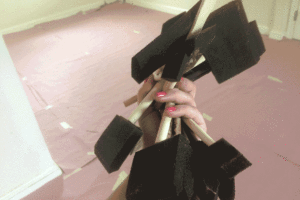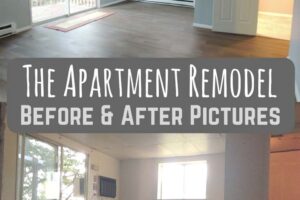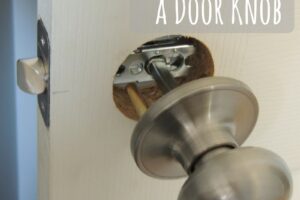We lucked out on our first flip when it came to the floors.
The entire first floor had beautiful hardwood that just needed some refinishing for their beauty to shine through.
But let me tell you…. I almost didn’t do this project DIY style! Why? Because while I was researching how to refinish hardwood floors before I started the project I was almost scared away from it! I read blog post upon blog post about how hard the sander was to control. And how the stain was hard to apply and came out blotchy. But I didn’t let it deter me. (I mean look at this after photo!)

Did you see the picture above?!?! I am so glad I decided to give sanding my own hardwood floors a try because it wasn’t that hard to do (I’m actually gearing up to do it again in our second fixer upper) and it saved us $2,500 on a professional, since most charge $4-$5 a square foot to refinish hardwood floors.
So let me take a moment to talk about when you should think about hiring a professional because let’s face it, there are some things we just can’t handle (whether we want to admit it or not.)
You should hire a professional if…
If you have some extremely dark pet stains and aren’t planning to stain the floor reallllllly dark, you should have a professional come and replace the wood because no amount of sanding will get out pet stains. (SIGH.)
You should also get a professional when the wood is severely cupped or uneven. It can take many rounds of really rough sandpaper to get them even… something that should be left up to someone who has seen that kind of thing a time or two.
Do you know if your floor is hardwood or engineered hardwood? That matters too. A professional should definitely be called in if it’s engineered hardwood, it’s really easy to damage this kind of floor and really expensive to fix when you eff it up DIY style.
How To Refinish Hardwood Floors
If you’re still reading, I guess I haven’t scared you away! Good! Because as long as your floors aren’t in terrible shape I don’t see why any person capable of mowing the lawn (with a push mower of course) wouldn’t be able to sand hardwood floors.
The hardwoods in our first flip weren’t in bad shape at all. Out of the entire living room, dining, hallway and bedroom there were only a few deep scratches and two boards that weren’t the exact same height (I could feel it in the way the sander glided over them and see that it left a shiny spot where it didn’t sand.) Both only required a few extra passes with the sander and they were taken care of.
 (We used a stainable wood putty!)
(We used a stainable wood putty!)
We started by filling in the gaps and nail holes with wood filler (stainable). I’m wondering now if that was a good idea. I’ve read on a few blog since then that the filler just cracks and falls out over the years, sometimes looking worse than before. I hope that’s not the case but if it is I’m sorry to whoever bought our first flip. (Let me know if you actually know the answer to this from experience in the comments, I’m sooooo curious!)
Anyway, after we did or did not do the right thing with the wood filler we took off all the quarter round so we’d be ready to immediately get to work when we got back with our 24 hour sander rental.
We rented a square buff floor sander from Home Depot and purchased 36 grit, 60 grit and 100 grit sandpaper per the rental guy’s recommendations.
We lugged the thing home in the bed of Mr. Stone Head’s truck and got to work. I wore a respirator because the dust is unbelievable and looking back now, I probably would wear goggles as well.
At first, the sander was a little awkward to use but it only took one pass and one turn to get used to and I was ready to settle into 8 hours of sanding. I went over the entire floor with each grit of sandpaper, vacuuming in between grits. It’s really important to get rid of the dust before each change in sandpaper.
If you don’t get rid of the dust, it heats up and almost melts and forms gummy debris which gunks up the sandpaper much faster.
 (In this photo you can see where I sanded on the left and where it still needs to be sanded on the right.)
(In this photo you can see where I sanded on the left and where it still needs to be sanded on the right.)
While I did the main floor the boyfriend started on the edges and corners where the floor sander wouldn’t reach with a regular hand sander and detail sander for the corners. We used the same 3 grits as the main floor – and it took fooorrrreeeeevvveeerrrr. We now know there is such a thing as an “edge floor sander” so maybe professionals use those to make the process faster- but maybe I’ll look into renting one for my next hardwood floor refinishing.
We did a final vacuuming and went around with a barely damp microfiber (<– yes that’s a link to 50!) and wiped the floors down as well, just to make sure the dust was totally gone.
Whew. Then we took a break.
The next step was staining with Minwax’s Special Walnut. First, I think it’s important to note that I started in the farthest area so I could work my way out! Yay for not staining myself into a corner!
 I started by edging with the stain just like I would with paint. I used a clean cotton cloth to wipe the stain on as close to the wall as possible making sure to work with the grain of the wood. Then I applied the stain as far as I could reach on the main floor, waited about 10 minutes and then wiped everything off with a separate cotton cloth. Then I just kept repeating this process for 5 hours and I was done!
I started by edging with the stain just like I would with paint. I used a clean cotton cloth to wipe the stain on as close to the wall as possible making sure to work with the grain of the wood. Then I applied the stain as far as I could reach on the main floor, waited about 10 minutes and then wiped everything off with a separate cotton cloth. Then I just kept repeating this process for 5 hours and I was done!

We loved the look of the floor after one coat of stain so we decided to leave it at that! I waited 24 hours for the stain to dry and then applied three coats of Minwax’s water based, oil modified polyurethane with a lambswool applicator attached to a pole (so I didn’t have to bend down.)
As a side note we also use Minwax’s fast drying polyurethane from time to time and like that as well. No matter what, I always end up with a few small air bubbles in the floor. But truthfully, I don’t care! I only notice them while crawling around on my hands and knees!
Anyway, like I said above, I’m in the process of getting the tools and materials together for my next hardwood floor refinishing project and this time I think I’m going to try yet another polyurethane and then decide which one is my favorite. Next time I’m thinking about using Rust-Oleum’s No Odor Floor Forumla Poly. Has anyone else tried this? Let me know!
And before I finish up here are some tips I thought might help with refinishing your floors!
Tips for How to Refinish Hardwood Floors:
- If renting a sander, make sure to prep the entire area before you get back with the sander! You wouldn’t believe how long taking shoe molding off can take and that eats into your rental time!
- Start moving with the sander as you turn it on, this will help eliminate waves in the floor.
- Vacuum in between sandings! It’s extremely important. Don’t be lazy on this, you’ll regret it.
- Don’t skip a grit when using multiple sandpapers.
- Use a damp microfiber before staining (but allow the floor to dry completely) to make sure every little bit of dust is gone.
- Hire a professional if the floors are pet stained, cupped or deeply scratched.
- Use throw away rags for the entire project! You won’t want to throw the stuff in your washer.
- Do your research on stains and polys!
- Good luck! And don’t forget to share your projects with me here on Instagram or here on Facebook!
And here’s the bedroom in our first flip where we refinished the hardwood floors… OoOOOoo AHhhhhhHhh






